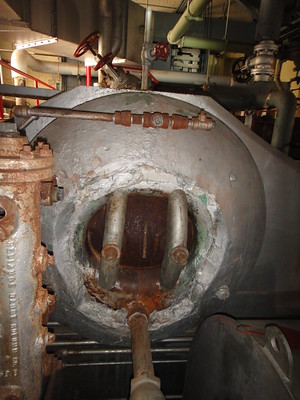Burnham Holdings
Established in 1905, Burnham Holdings is the parent company of manufacturers of boilers and related HVAC products and accessories. One of its subsidiaries, Burnham Commercial, has been involved in a number of lawsuits stemming from its asbestos-containing products.

Written by Daniel King • Edited By Walter Pacheco • Scientifically Reviewed By Sean Fitzgerald, PG
Asbestos.com is the nation’s most trusted mesothelioma resource
The Mesothelioma Center at Asbestos.com has provided patients and their loved ones the most updated and reliable information on mesothelioma and asbestos exposure since 2006.
Our team of Patient Advocates includes a medical doctor, a registered nurse, health services administrators, veterans, VA-accredited Claims Agents, an oncology patient navigator and hospice care expert. Their combined expertise means we help any mesothelioma patient or loved one through every step of their cancer journey.
More than 30 contributors, including mesothelioma doctors, survivors, health care professionals and other experts, have peer-reviewed our website and written unique research-driven articles to ensure you get the highest-quality medical and health information.
About The Mesothelioma Center at Asbestos.com
- Assisting mesothelioma patients and their loved ones since 2006.
- Helps more than 50% of mesothelioma patients diagnosed annually in the U.S.
- A+ rating from the Better Business Bureau.
- 5-star reviewed mesothelioma and support organization.
Testimonials
My family has only the highest compliment for the assistance and support that we received from The Mesothelioma Center. This is a staff of compassionate and knowledgeable individuals who respect what your family is experiencing and who go the extra mile to make an unfortunate diagnosis less stressful. Information and assistance were provided by The Mesothelioma Center at no cost to our family.LashawnMesothelioma patient’s daughter
How to Cite Asbestos.com’s Article
APA
King, D. (2024, March 25). Burnham Holdings. Asbestos.com. Retrieved April 19, 2024, from https://www.asbestos.com/companies/burnham-holdings/
MLA
King, Daniel. "Burnham Holdings." Asbestos.com, 25 Mar 2024, https://www.asbestos.com/companies/burnham-holdings/.
Chicago
King, Daniel. "Burnham Holdings." Asbestos.com. Last modified March 25, 2024. https://www.asbestos.com/companies/burnham-holdings/.
Burnham Holdings’ History with Asbestos

In addition to boilers and boiler insulation, Burnham Commercial manufactured and produced a number of asbestos-containing products, including fire-retardant bricks, gaskets and pipe insulation.
Adding asbestos fibers to the components made them more durable and resistant to heat and fire. Unfortunately, it also made them dangerous. Anyone who worked with Burnham Commercial’s boilers until the 1980s could be at risk of developing an asbestos-related disease such as mesothelioma.
Until the late 1980s, boilers contained a number of asbestos-containing products, including insulation around the boiler’s walls, tube banks and internal pipes, gaskets, bearings to paste lagging or even raw asbestos.
These materials remain in many commercial, residential and industrial buildings as well as ships built before 1975. Disturbing asbestos-containing parts on these boilers can lead to asbestos exposure.
Asbestos-related personal injury claims have been filed by individuals that were exposed to asbestos from Burnham Holdings products, more specifically, products from its Burnham Commercial facilities.
Unlike many companies that manufactured asbestos-containing products, Burnham has not created a bankruptcy trust for asbestos claims. Instead, the company has decided to continue to defend itself in court.

Asbestos Litigation Involving Burnham Holdings
Burnham has been asked to pay millions of dollars in asbestos claims. Because of the long latency period of asbestos-related conditions, between 20 to 60 years, the company expects more lawsuits in the future.
According to Burnham Holdings’ 2020 financial report, charges for uninsured litigation were $383,000 and expenses for legal counsel, consultants and other costs to defend claims (including asbestos claims) was $104,000.
In the company’s 2018 financial report, uninsured litigation cost them $1.25 million and they paid $187,000 to defend claims.
The company says it believes the vast majority of future asbestos claims should be resolved within existing insurance limits and reserves — whether it be through trial verdicts or out-of-court settlements.
However, Burnham Holdings officials did note that asbestos litigation involves many uncertainties and the company cannot predict the extent to which new claims will be filed or the financial impact it may have on the business.

Case of Five Plaintiffs Exposed to Asbestos
In July 2013, a New York jury awarded $190 million in an asbestos-related lawsuit involving Burnham Commercial. Five plaintiffs were exposed to asbestos while working in the plumbing, steamfitting and construction industries and developed mesothelioma as a result of their exposure.
One plaintiff handled and demolished boilers with asbestos-containing components throughout his career. Another plaintiff, a steamfitter, handled boilers containing asbestos.
A third plaintiff, a pipefitter, worked at New York’s Brooklyn Navy Yard from 1951 and 1966 and was exposed while handling pipes of distillers that processed saltwater. The other two plaintiffs were plumbers who handled boilers and pipes covered in asbestos.
Burnham Commercial’s monetary obligations for the five lawsuits totaled $42.2 million, or 21.2% of the total damages awarded. However, the company filed post-trial motions and appeals seeking to reduce or overturn the verdicts.
On February 9, 2015, New York Supreme Court Judge Joan Madden ruled that all five damage awards “deviate from reasonable compensation,” and significantly reduced Burnham Commercial’s liability to less than $7 million.
Case of Steamfitter Charles Hillyer
In 2014, a separate lawsuit returned a $6 million verdict against the company, but that too was later reduced by an appeals court to less than $2 million. The plaintiff in that case, Charles Hillyer, allegedly developed mesothelioma from asbestos exposure while working as a steamfitter from 1960 to 1983.
Hillyer testified he had been exposed to asbestos insulation on boilers, including those made by Burnham Commercial. He was diagnosed with mesothelioma in March 2013 and died in September 2014. Hillyer’s family took over the lawsuit after his death.
In Hillyer’s case, New York judge Cynthia Kern ruled the $20 million award for past pain and suffering against Burnham and several other boiler manufacturers “deviates materially from what would be reasonable.” The total award was reduced to $6 million, with Burnham’s liability reduced to $2 million.
Burnham Holdings’ Asbestos Products and Workers at Risk
The following asbestos-containing products were manufactured by Burnham
- Boilers
- Boiler insulation
- Pipe insulation
- Fire-retardant bricks
- Gaskets
Burnham’s boilers contained asbestos through the 1980s. Anyone who manufactured these products or worked around Burnham boilers in their career was at risk of asbestos exposure.
The following occupations were at risk of working around Burnham’s asbestos-containing products
- Boiler workers
- Boiler technicians
- Boiler repairmen
- HVAC installers
- HVAC mechanics
- Steamfitters
- Pipefitters
- Brick masons
- Plumbers
- Power plant workers
- Industrial workers
- Maintenance workers
- Shipyard workers
- Veterans of the armed forces
Burnham Holdings History
Burnham Commercial traces its origins to the mid-1880s when Frederick A. Lord founded a New York-based greenhouse manufacturer, then named Lord’s Horticultural Manufacturing Company. In 1872, Lord’s son-in-law, William Burnham, joined the company to help make greenhouses for large estates in upstate New York.
Shortly after, the greenhouse industry was in need of a solution to provide adjustable and evenly distributed heat to large areas, which motivated the company to make its first cast iron boiler. Lord’s Horticultural Manufacturing Company later became known as the Lord & Burnham Company.
In 1905, it merged with the Pierson-Sefton Company and the Hitchings Company, which specialized in manufacturing heating systems and ventilating systems for greenhouses, to form the Burnham-Pierson-Sefton Corporation.
Following growth and acquisitions, the Burnham Boiler Company was established in 1919 and took over the boiler business from Lord & Burnham Company and its affiliated companies. The company was renamed Burnham Corporation and is currently referred to as Burnham Commercial, and it is owned by Burnham Holdings.
Today, headquartered in Lancaster, Pennsylvania, Burnham Commercial continues to produce steam and hot water boilers for commercial and industrial applications, although asbestos is no longer added to components. The company’s products are sold in the U.S., Canada and Mexico and are used throughout schools, government buildings, places of worship and historical sites.







